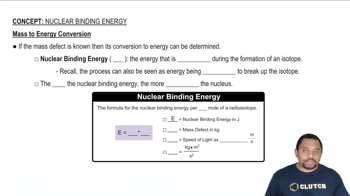Textbook Question
Write balanced nuclear equations for the following processes:
(a) rubidium-90 undergoes beta emission.
99
views




Write balanced nuclear equations for the following processes:
(a) rubidium-90 undergoes beta emission.
Write balanced nuclear equations for the following processes:
(b) selenium-72 undergoes electron capture.
Write balanced nuclear equations for the following processes: (c) krypton-76 undergoes positron emission.
Write balanced nuclear equations for the following transformations:
(b) nitrogen-13 undergoes electron capture.
Write balanced nuclear equations for the following transformations: (c) technicium-98 undergoes electron capture.
Decay of which nucleus will lead to the following products: (a) bismuth-211 by beta decay?